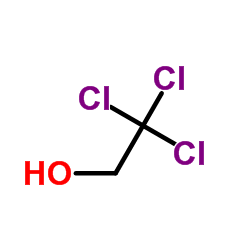Ethapon

Ethapon structure
|
Common Name | Ethapon | ||
|---|---|---|---|---|
| CAS Number | 115-20-8 | Molecular Weight | 149.404 | |
| Density | 1.6±0.1 g/cm3 | Boiling Point | 152.1±35.0 °C at 760 mmHg | |
| Molecular Formula | C2H3Cl3O | Melting Point | 17.8 °C(lit.) | |
| MSDS | Chinese USA | Flash Point | 45.8±25.9 °C | |
| Symbol |


GHS05, GHS07 |
Signal Word | Danger | |
|
Validation of a general method for activity estimation of cyanide evolving oxidoreductases.
Anal. Biochem. 471 , 44-50, (2015) Ethylene is a key molecule in organic synthesis currently produced by steam cracking of fossil hydrocarbons. In nature, ethylene is produced in higher plants by 1-aminocyclopropane-1-carboxylic acid oxidase (ACCO). Biocatalytic alternatives for ethylene produ... |
|
|
Trichloroethylene and trichloroethanol-induced formic aciduria and renal injury in male F-344 rats following 12 weeks exposure.
Toxicology 323 , 70-7, (2014) Trichloroethylene (TCE) is widely used as a cleaning and decreasing agent and has been shown to cause liver tumours in rodents and a small incidence of renal tubule tumours in male rats. The basis for the renal tubule injury is believed to be related to metab... |
|
|
Interaction proteomics of canonical Caspr2 (CNTNAP2) reveals the presence of two Caspr2 isoforms with overlapping interactomes.
Biochim. Biophys. Acta 1854 , 827-33, (2015) Autism is a human developmental brain disorder characterized by impaired social interaction and communication. Contactin-associated protein-like 2 (Caspr2, CNTNAP2) is a known genetic risk factor of autism. However, how this protein might contribute to pathol... |
|
|
Comparative analysis of the relationship between trichloroethylene metabolism and tissue-specific toxicity among inbred mouse strains: kidney effects.
J. Toxicol. Environ. Health A 78(1) , 32-49, (2015) Trichloroethylene (TCE) is a well-known environmental and occupational toxicant that is classified as carcinogenic to humans based on the epidemiological evidence of an association with higher risk of renal-cell carcinoma. A number of scientific issues critic... |
|
|
Comparative analysis of the relationship between trichloroethylene metabolism and tissue-specific toxicity among inbred mouse strains: liver effects.
J. Toxicol. Environ. Health A 78(1) , 15-31, (2015) Trichloroethylene (TCE) is a widely used organic solvent. Although TCE is classified as carcinogenic to humans, substantial gaps remain in our understanding of interindividual variability in TCE metabolism and toxicity, especially in the liver. A hypothesis w... |
|
|
Development of indole chemistry to label tryptophan residues in protein for determination of tryptophan surface accessibility.
Protein Sci. 16(6) , 1204-13, (2007) Solvent accessibility can be used to evaluate protein structural models, identify binding sites, and characterize protein conformational changes. The differential modification of amino acids at specific sites enables the accessible surface residues to be iden... |
|
|
Trichloroethanol up-regulates matrix metalloproteinase-9 and tissue inhibitor of metalloproteinase-1 in HaCaT cells
Toxicol. In Vitro 25(8) , 1638-43, (2011) Highlights ► We assess sensitizing potential of trichloroethanol or trichloroacetic acid in vitro. ► We use HaCaT cell line as mode cell and matrix metalloproteinases as responders. ► TCOH could induce MMP-9 increase in a dose–effect mode in HaCaT cell. ► TCA... |
|
|
Lack of formic acid production in rat hepatocytes and human renal proximal tubule cells exposed to chloral hydrate or trichloroacetic acid.
Toxicology 230(2-3) , 234-43, (2007) The industrial solvent trichloroethylene (TCE) and its major metabolites have been shown to cause formic aciduria in male rats. We have examined whether chloral hydrate (CH) and trichloroacetic acid (TCA), known metabolites of TCE, produce an increase in form... |
|
|
Micronucleus induction by oxidative metabolites of trichloroethylene in cultured human peripheral blood lymphocytes: a comparative genotoxicity study.
Environ. Sci. Pollut. Res. Int. 20(12) , 8709-16, (2013) The genotoxic effects of oxidative metabolites of trichloroethylene (TCE), namely chloral hydrate, trichloroacetic acid (TCA), dichloroacetic acid (DCA), and trichloroethanol (TCEOH) were examined in human peripheral blood lymphocytes. In this context, lympho... |
|
|
Arginine 246 of the pretransmembrane domain 1 region alters 2,2,2-trichloroethanol action in the 5-hydroxytryptamine3A receptor.
J. Pharmacol. Exp. Ther. 324(3) , 1011-8, (2008) Ligand-gated ion channels participate in synaptic transmission, and they are involved in neurotransmitter release. The functions of the channels are regulated by a variety of modulators. The interaction of 2,2,2-trichloroethanol, the active hypnotic metabolit... |